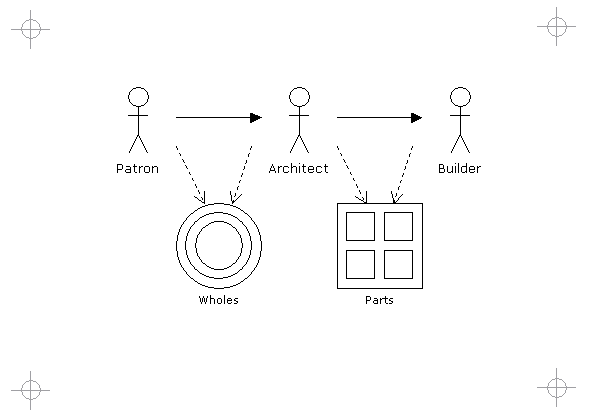|
Diagram
|
|
|

|
|
Title
|
|
|
Patron Architect Builder
|
|
Building Architecture
|
|
|
The patron-architect-builder relationship is one of the cornerstones of architectural theory, design and construction. It is a model for defining roles. It can represent or be represented by one or more individuals or actors.
|
|
Architecture Intensive Disciplines
|
|
|
The patron-architect-builder is a pattern for the main actor role collaborations in architecture intensive disciplines. The architect must correctly inteprete the requirements or vision of the patron and balance the relationship between patron and builder to derive a mutually benefitial outcome. The model is simple but the application can be complex. It involves technical skills as well as human values and belief systems.
|
|
Case Study A: Large Corporate IT
|
|
|

|
|
|
Business analysts were usually allocated to the business units and regarded as the customer representative. The architect interfaced with the technical team, project managers, business analysts and team leaders to ensure architectural integrity and quality in design. The role required a technical leader and one whose purview of the software was that of the whole rather than its parts.
Many software architects report to a development manager or an IT management team. In many ways the patron is made up of the development manager, project sponsor, project manager, business analysts and expert users. In a large organisation, the architect often has to integrate and balance many visions and it is often an over simplification to state that "the customer is the patron" - although ideally this should be the case.
|
|
Case Study B: Small Commercial Team
|
|
|

|
|
|
As in the other case study the architect here reported to the development manager. This was one of the key patterns in this case study. In Extreme Programming (XP) the customer is part of the team. We could not produce a customer as part of the team. In this case, the architect functions as a technical lead but the business analyst would interface with the corporate clients and perform the role of business architects. It was noted in our project review that the absence of an on-site customer made it difficult to properly be customer focused. If there was one single failing, it was this inability to address market and customer demands - a critical error in any commercial software venture.
|
|
|


